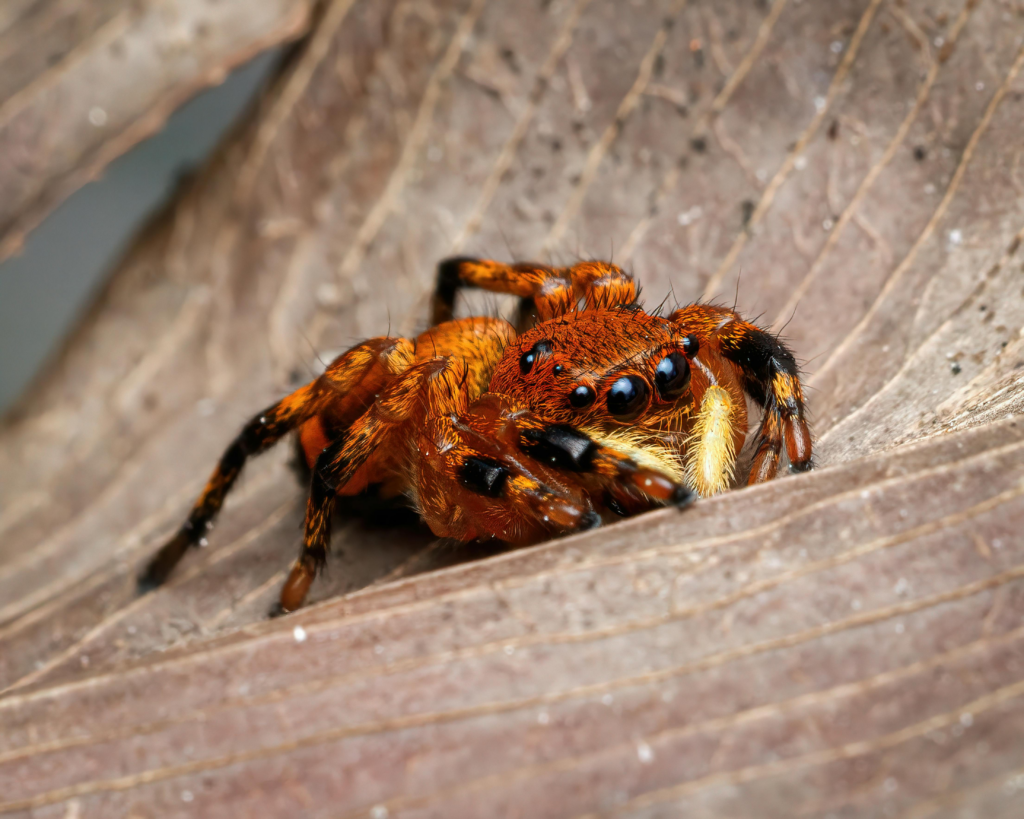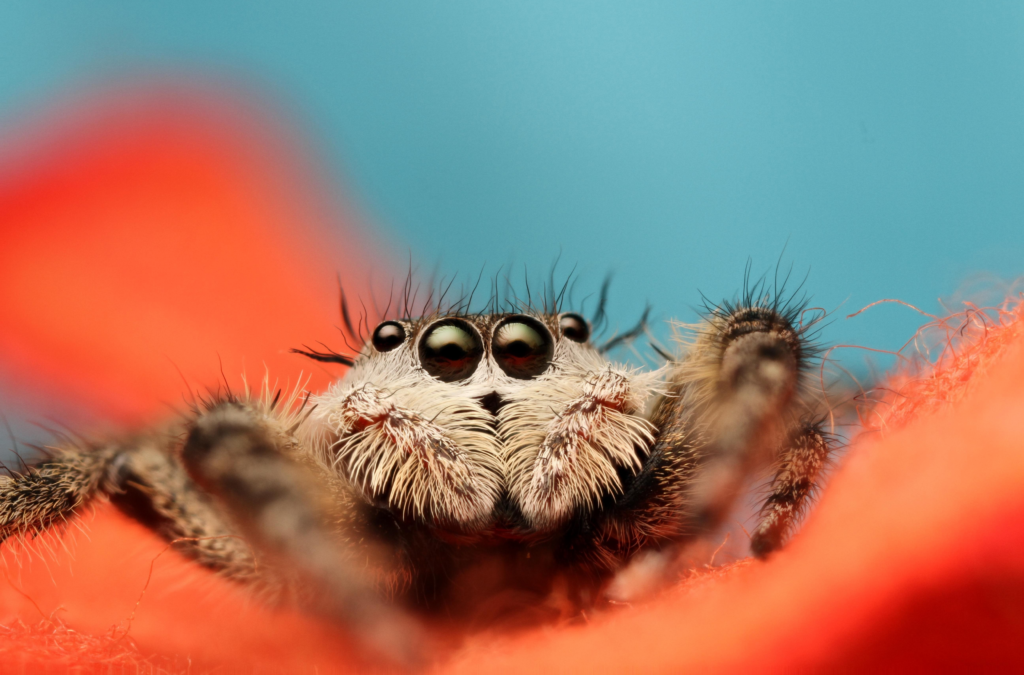You may ask are jumping spiders poisonous? They are not poisonous to humans. Jumping spiders are small spiders found in gardens and homes. They use venom to catch insects, but their bites rarely hurt people. Scientists say their venom is for hunting, not for attacking humans.
This article looks into if jumping spiders are poisonous. It also talks about their venom and how they behave.
If you are interested in getting them serviced click here.

Key Takeaways
- Jumping spiders have venom but pose minimal risk to humans.
- Their venom is used to subdue small prey, not for defense.
- No severe reactions to jumping spider bites have been reported in medical records.
- Jumping spiders play a helpful role in controlling pests without threatening safety.
- Understanding their venom helps people avoid unnecessary fear of these spiders.
Introduction to Jumping Spiders
Jumping spiders are small and agile. They live in gardens, homes, and nature across the U.S. Their striking features and active behavior make them stand out. Knowing about them helps clear up myths and safety worries.

Overview of Jumping Spider Characteristics
Jumping spiders have some cool facts:
- Exceptional vision: They have four big front eyes for sharp sight.
- Acrobatic movements: They jump up to 50 times their body length, using silk for balance.
- Active hunters: Unlike web-spinners, they chase insects with speed and skill.
Habitat and Behavior
These spiders live in many places, from sunny yards to indoor spots. Their main behaviors are:
- Daytime activity: They’re most active during the day, often seen on walls or plants.
- Indoor presence: They might accidentally enter homes but are not dangerous. Their bites are minor and rarely need medical help.
- Pest control role: They eat mosquitoes and flies, helping gardens.
Are Jumping Spiders Poisonous? Debunking Myths
Jumping spiders are often misunderstood. People think they are dangerous because of their venom. But, they are not a threat to humans. Let’s look at the truth about these tiny arachnids.
Understanding Venom Mechanisms
Jumping spiders use venom to catch insects. Their venom breaks down the insect’s tissue. This makes it easier for them to eat.
For humans, a bite is just a mild pinch. It might cause a little redness or swelling. But their venom is not harmful to people.
Comparisons with Other Spider Species
Jumping spiders are different from dangerous spiders like black widows or brown recluses. Here are some key differences:
- Purpose of venom: Jumping spiders use venom to catch small insects. Their fangs are too small to hurt mammals.
- Medical impact: Bites from black widows or hobo spiders can be very painful. They can even cause muscle cramps or necrosis. But jumping spider bites don’t need medical help.
- Behavior: Jumping spiders run away when scared. But aggressive spiders like brown recluses might bite without warning.
Knowing how to identify jumping spiders can help. They hunt actively and have big front eyes. This helps us tell them apart from dangerous spiders. It also helps us live peacefully with them.
Jumping Spider Venom: What You Need to Know
Jumping spider venom is made to catch small prey, not harm humans. Their tiny mouthparts and mild venom usually cause just a little redness or itch. Unlike dangerous spiders, their bites are rarely serious.
If you get bitten, follow the right spider bite treatment steps. First, clean the area with soap and water right away. Then, use a cold pack to lessen swelling. You can also take over-the-counter pain relievers to feel better. Watch for signs of infection or allergic reactions.
- Wash the bite area gently with mild soap.
- Use a clean cloth with ice to numb the site.
- Elevate the affected limb if swelling occurs.
- Seek medical care if symptoms worsen after 24 hours.
Even though jumping spider venom isn’t strong, quick spider bite treatment helps avoid bigger problems. Severe pain, trouble breathing, or spreading redness need fast doctor help. Most bites get better with simple care, showing the need to stay calm and act carefully.
Identifying Jumping Spiders: Key Characteristics
Learning to spot jumping spiders is easy once you know their unique features. They look and act differently from dangerous spiders. This makes them easy to tell apart with a little practice.
Visual Identification Tips
- Body size: They are 0.5–2 cm long, which is small and sturdy.
- Eye pattern: They have four rows of eyes, with two big eyes in the front.
- Coloration: They often have bright colors like black, gray, or brown. They might also have white spots or stripes.
- Leg structure: Their legs are strong and well-proportioned for jumping.

Distinguishing Poisonous Versus Non-Poisonous Spiders
Jumping spiders are safe for humans, but they look very different from dangerous ones:
- Jumping spider behavior is quick and purposeful. They don’t move wildly like some dangerous spiders.
- Are jumping spiders friendly? Yes, they run away from people. They also don’t have big enough fangs to hurt us, unlike some other spiders.
- Look for red hourglass marks or a violin-shaped abdomen to tell them apart from dangerous spiders.
By using these tips, you can safely enjoy watching them. They play an important role in controlling pests, as we’ll see later.
Spider Bite Symptoms and Effective Treatments
Most times, jumping spider bites cause only mild reactions. It’s important to know how to spot and treat these bites. Even though they’re not venomous, their bites can be uncomfortable. Quick action can stop minor problems from getting worse.
Recognizing a Jumping Spider Bite
Common signs of a bite include:
- Redness or a small red mark at the site
- Mild swelling or itching within minutes
- Rarely, a tiny puncture wound visible
These symptoms usually go away in a few hours. You don’t need to rush to the hospital unless they get worse.
When to Seek Medical Help
Get help right away if you notice:
- Severe swelling spreading beyond the bite area
- Breathing difficulties or dizziness
- Signs of infection, like pus or fever
- Suspected bites from venomous spiders such as black widows or brown recluses
Seeing a doctor fast is key for serious reactions or allergies. Keep an eye on your symptoms, even after treatment.
Understanding Jumping Spider Behavior and Ecology
Jumping spiders love the daylight. They use their sharp eyes and quick moves to stay alive. Watching their daily lives can help us avoid spider bites and learn how to identify them.
Their ways of living and their role in nature teach us how to live in harmony with them.
Daily Activity Patterns
Jumping spiders are most active during the day. They have eight eyes to find food and can jump really far. Unlike spiders that hunt at night, they make temporary webs to rest in.
They don’t trap prey in webs. Instead, they stalk their food.
Role in Natural Pest Control
- They eat mosquitoes, flies, and other bugs, keeping pest numbers down.
- Gardens are healthier because they control aphids and mites without chemicals.
Knowing how they help can make us more accepting of them. Seeing them outdoors means our environment is balanced. This means we don’t need to use harmful chemicals.

Tips for Safe Interaction with Jumping Spiders
Jumping spiders are common in homes and gardens. They are harmless, making it easy to live with them. Just follow these simple steps:
- Use a container and card: Catch the spider in a jar. Slide cardboard under the opening. Then, release it outside.
- Avoid pesticides: Chemical sprays harm good spiders. They help control pests like mosquitoes and flies.
- Observe from a safe distance: Jumping spiders rarely bite. If scared, they’ll jump away instead.
Prevent encounters by:
- Sealing gaps in windows, doors, and walls.
- Trimming plants near foundations to reduce hiding spots.
- Using natural light traps for flying insects to cut indoor food sources.
Respect their role in ecosystems—jumping spiders eat harmful insects. By following these tips, you protect your space and these helpful spiders. Learning about local spiders reduces fear and promotes living together.
Comparative Analysis: Poisonous vs. Non-Poisonous Spiders
Understanding spider safety means knowing the difference between venomous and non-venomous spiders. Jumping spiders are venomous but not as dangerous as black widows or brown recluses. Knowing these differences helps us assess risks and control spider pests better.
Notable Differences in Venom and Behavior
Some spiders are more dangerous than others:
- Venom Potency: Jumping spiders have mild venom for catching small prey. Black widows have strong venom that hurts a lot.
- Aggression Levels: Jumping spiders bite only when they can’t get away. Brown recluses might bite when they feel threatened.
- Physical Traits: Poisonous spiders have special signs like hourglass shapes. Jumping spiders have many colors and move quickly.

Implications for Spider Pest Control
Good pest control plans focus on the right spiders:
- Know which spiders are harmless to avoid treating them.
- Target pest control at dangerous spiders. Let helpful spiders like jumping spiders eat garden pests.
- Use special prevention for high-risk spiders, like sealing holes for recluse spiders.
Conclusion
Jumping spiders have venom but are not a big threat to humans. Their venom is mainly for small prey. Bites usually don’t cause serious problems.
Watching how they hunt during the day and like being outside helps us avoid them. They help control pests like mosquitoes and flies. This makes them good for gardens and homes.
Knowing about their behavior helps us not be scared. They usually run away when we come near. If bitten, you might see some redness or itchiness, but serious issues are rare.
Seeing a doctor is only needed if you have an allergic reaction or swelling. Learning about their behavior and how to tell them apart lets us live safely with them. We can enjoy their role in nature without fear.



